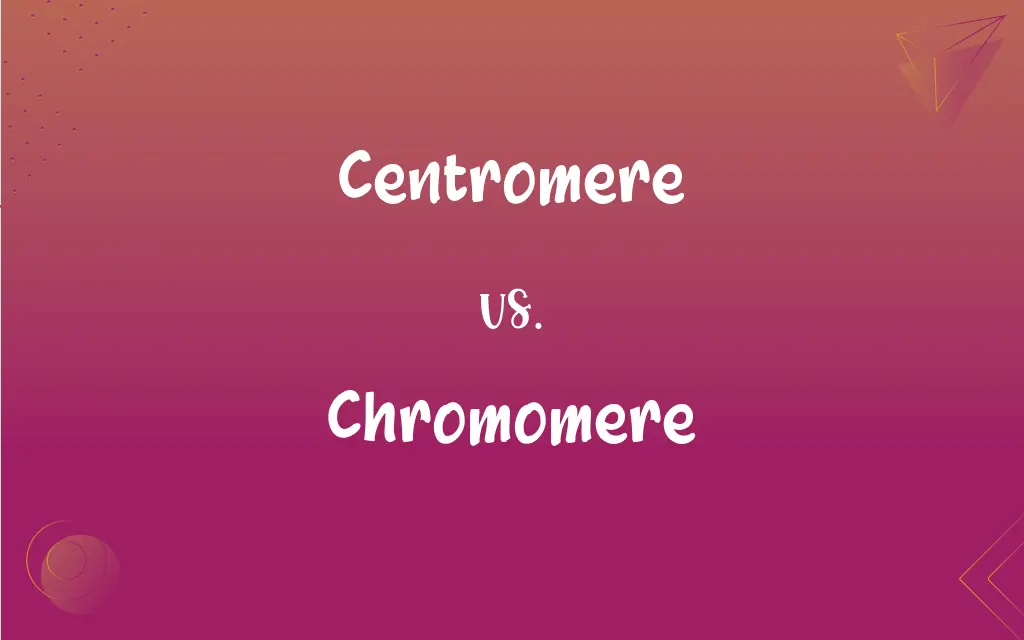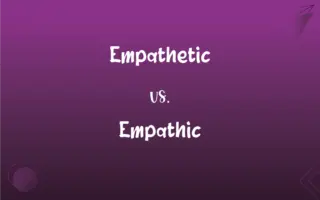Centromere vs. Chromomere: What's the Difference?
Edited by Janet White || By Harlon Moss || Updated on October 29, 2023
Centromere is the part of a chromosome that links sister chromatids, while chromomere is a bead-like structure on a chromosome.

Key Differences
A centromere is a constricted region of a chromosome that separates it into two sections, while a chromomere is a bead-like structure on a chromosome. The centromere is vital for the movement of chromosomes during cell division, whereas chromomeres play no role in this process. The structure of a centromere includes specific DNA sequences that are required for its function, unlike chromomeres. Centromeres are essential for the correct segregation of chromosomes, whereas chromomeres help to organize the chromosome. In conclusion, while both centromeres and chromomeres are components of chromosomes, they have different roles and structures.
The centromere is an important structure in a chromosome that ensures the accurate separation of chromatids during cell division. In contrast, chromomeres are bead-like structures that are part of the larger structure of a chromosome. The centromere contains specific DNA sequences that are essential for its function, unlike chromomeres. Furthermore, centromeres are necessary for the proper segregation of chromosomes, whereas chromomeres simply help to organize the chromosome. Therefore, while both centromeres and chromomeres are components of chromosomes, they have distinct functions and characteristics.
The centromere is a crucial structure in a chromosome, playing a vital role in the segregation of chromatids during cell division. In contrast, chromomeres are simply bead-like structures on a chromosome that help to organize it. The centromere contains specific DNA sequences that are necessary for its function, whereas chromomeres do not. Additionally, centromeres are essential for the correct segregation of chromosomes, while chromomeres are not. In conclusion, although both centromeres and chromomeres are parts of chromosomes, they have different roles and structures.
The centromere is a constricted region of a chromosome that is necessary for the movement of chromosomes during cell division, whereas chromomeres are bead-like structures on a chromosome that have no role in this process. The centromere contains specific DNA sequences that are required for its function, unlike chromomeres. Furthermore, centromeres are essential for the proper segregation of chromosomes, while chromomeres help to organize the chromosome. Therefore, while both centromeres and chromomeres are parts of chromosomes, they serve different purposes and have different characteristics.
Comparison Chart
Region of a chromosome
Location
Bead-like structure on a chromosome
ADVERTISEMENT
Involved in chromosome movement
Role in cell division
Not involved in chromosome movement
Has specific DNA sequences
DNA sequences
Does not have specific DNA sequences
Necessary for chromosome segregation
Importance in cell survival
Not necessary for chromosome segregation
Essential for cell survival
Organizational role
Helps organize the chromosome
Centromere and Chromomere Definitions
Centromere
A centromere is a region on a chromosome that links sister chromatids.
During cell division, the centromere ensures the chromatids separate correctly.
ADVERTISEMENT
Chromomere
A chromomere is a bead-like structure on a chromosome.
Chromomeres help organize the chromosome into a compact form.
Centromere
The centromere is involved in the movement of chromosomes.
The spindle fibers attach to the centromere to pull the chromatids apart.
Chromomere
Chromomeres are visible under a microscope.
They appear as darker areas on the chromosome.
Centromere
Centromeres contain specific DNA sequences.
These DNA sequences are necessary for the centromere's function.
Chromomere
Chromomeres are involved in the folding of chromosomes.
This folding helps the chromosome fit inside the cell nucleus.
Centromere
Centromeres are necessary for proper chromosome segregation.
If the centromere is not functioning properly, the chromatids may not separate correctly.
Chromomere
Chromomeres are not involved in chromosome movement.
They play a role in organizing the chromosome but not in its movement during cell division.
Centromere
Centromeres are essential for cell survival.
Without proper centromere function, the cell may not survive.
Chromomere
Chromomeres are found along the length of a chromosome.
Each chromomere contains a specific part of the chromosome's DNA.
Chromomere
One of the serially aligned beadlike granules of concentrated chromatin that constitutes a chromosome during the early phases of cell division.
Chromomere
(genetics) Any of a group of beadlike granules of chromatin that constitutes a chromosome during cell division.
FAQs
Where is the centromere located?
The centromere is located at a constricted region on the chromosome.
What is the role of the centromere?
The centromere is involved in the movement of chromosomes during cell division.
What is a chromomere?
A chromomere is a bead-like structure on a chromosome.
Where is the chromomere located?
Chromomeres are found along the length of a chromosome.
Does the chromomere contain specific DNA sequences?
Each chromomere contains a specific part of the chromosome's DNA.
What happens if the centromere is not functioning properly?
If the centromere is not functioning properly, the chromatids may not separate correctly during cell division.
What are the functions of the chromomere?
The functions of the chromomere include helping to organize the chromosome into a compact form and containing specific parts of the chromosome's DNA.
What is a centromere?
A centromere is a region on a chromosome that links sister chromatids.
Can the chromomere be seen under a microscope?
Yes, the chromomere can be seen under a microscope as darker areas on the chromosome.
Is the centromere involved in chromosome movement?
Yes, the centromere is involved in chromosome movement during cell division.
Is the chromomere involved in chromosome movement?
No, the chromomere is not involved in chromosome movement during cell division.
Is the centromere necessary for chromosome segregation?
Yes, the centromere is necessary for proper chromosome segregation during cell division.
What are the functions of the centromere?
The functions of the centromere include involvement in chromosome movement, ensuring correct chromatid separation, and being essential for cell survival.
Does the centromere contain specific DNA sequences?
Yes, the centromere contains specific DNA sequences that are necessary for its function.
What happens if the chromomere is not functioning properly?
If the chromomere is not functioning properly, the chromosome may not be organized correctly.
Is the chromomere necessary for chromosome segregation?
No, the chromomere is not necessary for chromosome segregation during cell division.
What is the role of the chromomere?
Chromomeres help organize the chromosome into a compact form.
Is the centromere necessary for cell survival?
Yes, the centromere is essential for cell survival.
Is the chromomere necessary for cell survival?
No, the chromomere is not necessary for cell survival.
Can the centromere be seen under a microscope?
Yes, the centromere can be seen under a microscope.
About Author
Written by
Harlon MossHarlon is a seasoned quality moderator and accomplished content writer for Difference Wiki. An alumnus of the prestigious University of California, he earned his degree in Computer Science. Leveraging his academic background, Harlon brings a meticulous and informed perspective to his work, ensuring content accuracy and excellence.
Edited by
Janet WhiteJanet White has been an esteemed writer and blogger for Difference Wiki. Holding a Master's degree in Science and Medical Journalism from the prestigious Boston University, she has consistently demonstrated her expertise and passion for her field. When she's not immersed in her work, Janet relishes her time exercising, delving into a good book, and cherishing moments with friends and family.
































































